Abstract
Photovoltaic panels play a pivotal role in the renewable energy sector, serving as a crucial component for generating environmentally friendly electricity from sunlight. However, a persistent challenge lies in the adverse effects of rising temperatures resulting from prolonged exposure to solar radiation. Consequently, this elevated temperature hinders the efficiency of photovoltaic panels and reduces power production, primarily due to changes in semiconductor properties within the solar cells. Given the depletion of limited fossil fuel resources and the urgent need to reduce carbon gas emissions, scientists and researchers are actively exploring innovative strategies to enhance photovoltaic panel efficiency through advanced cooling methods. This paper conducts a comprehensive review of various cooling technologies employed to enhance the performance of PV panels, encompassing water-based, air-based, and phase-change materials, alongside novel cooling approaches. This study collects and assesses data from recent studies on cooling the PV panel, considering both environmental and economic factors, illustrating the importance of cooling methods on photovoltaic panel efficiency. Among the investigated cooling methods, the thermoelectric cooling method emerges as a promising solution, demonstrating noteworthy improvements in energy efficiency and a positive environmental footprint while maintaining economic viability. As future work, studies should be made at the level of different periods of time throughout the years and for longer periods. This research contributes to the ongoing effort to identify effective cooling strategies, ultimately advancing electricity generation from photovoltaic panels and promoting the adoption of sustainable energy systems.
1. Introduction
The continued population growth has resulted in the need for more energy resources to satisfy different sectors of life [1,2,3,4]. Further, the continued use of fossil fuels has led to depletion of resources and increases in price and CO2 in the atmosphere. Therefore, current research focuses on finding alternative solutions through renewable energy resources [5,6] and heat recovery systems [7,8,9,10].
Solar energy forms an important factor in renewable energy resources, mainly through photovoltaic (PV) panels. Solar-energy-based PVs constitute a widely used technology in modern life based on the principle of converting sunlight into electricity through semiconductor materials. This technology enabled a great leap forward in the world of renewable energy resources due to its environmental impact on the reduction in CO2 emissions, its fast payback period, and its long maintenance period (every 25–30 years). However, the need for innovative installation techniques on modern roofs, the high prices, and the low power generation on rainy days are obstacles to the installation of this technology.
The main obstacle in this technology is its low efficiency due to high temperatures. The constant contact of sun rays at the surface of the PV panel increases its temperature, thus decreasing its efficiency and output power. It was found that the efficiency of crystalline silicon solar cells falls by 0.45–0.6% for every 1 °C rise above STC (standard test conditions) in solar cell temperatures and varies according to the type of cell [11].
To increase the efficiency and the affordability of the panels, different approaches were recorded in the trial to reduce solar cell temperatures. In the literature, four cooling techniques are demonstrated with their different methods. The first technique is using passive and active cooling methods of water. The second cooling technique is the use of free and forced convection of air. The third cooling technique is the use of phase-change materials (PCM) to absorb the excess of heat produced by the PV panel. Then the last cooling technique is a sum of uncategorized and modern methods.
Table 1 portrays a collection of recent studies on different cooling techniques of photovoltaic panels using novel approaches. The studies cover research and review articles.

Table 1.
Recent research conducted on cooling PV panels using different novel methods.
In summary, this review paper aims to comprehensively explore various aspects of photovoltaic cooling methods. Most research concentrates on discussing specific cooling systems or evaluating them from a performance perspective, including photovoltaic–thermal collectors, concentrated PV cells, PVT systems in buildings, environmental impacts of cooling technologies, and various cooling methods such as air cooling, water-based systems, phase-change materials, and passive cooling techniques. The manuscript’s novelty lies in its discussion of different technologies used in cooling PV panels while providing insights into the economic and environmental benefits of each cooling method.
This comprehensive review paper takes a unique and methodical approach to exploring various cooling methods for photovoltaic panels, distinguishing itself from previous research that often narrowly focused on specific systems or performance aspects. The goal is to provide a thorough and current analysis of advanced cooling technologies for solar systems, shedding light on both their economic and environmental benefits. Covering a diverse array of topics, from photovoltaic–thermal collectors to concentrated PV cells, the review showcases advancements in electrical and thermal efficiency, resulting in significant reductions in payback periods. This study emphasizes the critical role that cooling methods play in enhancing the sustainability and efficiency of PV systems. Noteworthy findings include the effectiveness of hybrid systems, thermoelectric, phase-change materials, and nano-based cooling methods in improving overall PV performance. Through this systematic categorization and assessment, coupled with insightful economic and environmental considerations, this research contributes valuable recommendations for future studies and advances in the realm of PV cooling methods, making a substantial contribution to the field.
The manuscripts mentioned in Table 1 provides valuable insights on future work and limitations that should be addressed that could be conducted in this field such as
- PVT collectors should take into consideration the available space of installation.
- Heat pipe PVT collectors are better in cooling than PVT collectors with refrigerants. However, their manufacturing and installation could be challenging.
- BIPVT collectors reduce the use of fossil fuels through offering savings at the level of electricity production and the materials that could be used.
- The PCM selection to be used for cooling could be challenging and depend on many factors. Studies should be performed at the level of the PCM to select the optimal one for this study.
- Pulsating flow for CPV cooling was found to increase the PV performance. It is suggested that this could be overcome through experimentation with the vibrations that come with pulsating flow for CPV collectors.
- It is suggested to study CPV cooling with the integration of porous media, PCM, or nanofluids.
- Building artificial intelligence devices to remove accumulated dust on PV panels as a means of cleaning and increasing efficiency.
- Despite the amount of research conducted in this field, more research needs to be performed to cover the different aspects of PV deterioration.
2. Theoretical Background
2.1. Principle
The phenomenon of photovoltaic energy was first discovered by Edmund Bequerel. The principle behind it is that when a photon reaches a semiconductor, two conductors are created: the free electron and the electron hole through rejection of the electrons by the negative transitional surface of the polarity. The released electrons flow to the upper layer. In the bottom layer, the electrons are transferred from one atom to the other in order to fill the empty spaces. Free electrons are conducted from the upper layer into the electric field, where the solar cell is located. The constant contact of sunlight on the surface of the solar panel ensures the continuity of electricity generation.
2.2. Parameters Affecting Panel Efficiency
Scientists and engineers found through experimental and numerical studies that different parameters other than panel temperature would affect its efficiency. Jathar et al. [25] reviewed the different environmental factors affecting PV panel efficiency. Environmental factors affecting panel efficiency are shown in Figure 1.
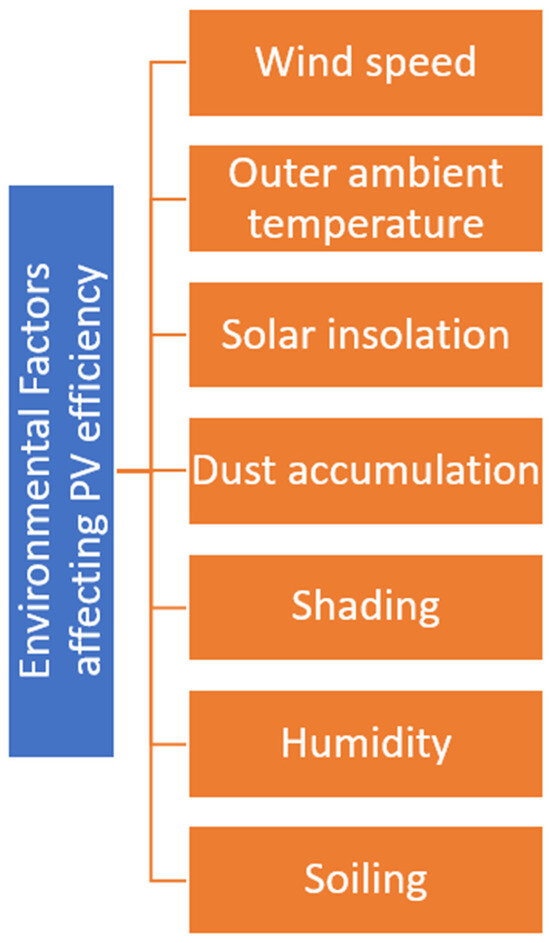
Figure 1.
Environmental factors affecting the efficiency of PV panels [25].
2.3. Effect of Temperature on Panel Efficiency
Among all the mentioned parameters in Figure 1, temperature is dominant in efficiency deterioration. A PV panel absorbs approximately 80% of the incident radiation, but not all of it is converted into electricity. A definite range of wavelengths can be converted into electricity and all the others are converted into heat [26]. The remainder unconverted wavelengths can increase the solar cell temperature above the atmospheric temperature [27].
The current literature has proven the decrease in temperature coefficients (such as PV voltage and open-circuit current) with the increase in temperature [28]. Chander et al. [29] carried out an experimental study employing a solar cell simulator with varying cell temperatures, and the results showed that cell temperature has a significant effect on the PV parameters and controls the quality and performance of the solar cell.
The current literature has also shown that there are many advantages and disadvantages of using each cooling method. The advantages and disadvantages of using the standardized cooling methods of air, PCM, and water are represented in Figure 2.
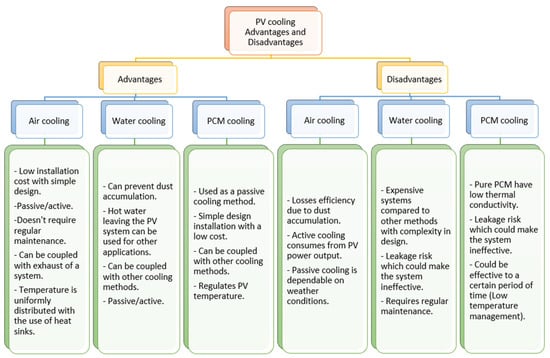
Figure 2.
Advantages and disadvantages of cooling methods.
2.4. Governing Equations
Every PV panel has a length L, a width W, and a thickness t. To calculate the total area of a PV panel, then,
where
A: Area of the P panel ().
L: Length of the PV panel ().
W: Width of the PV panel ().
However, the effective area of the PV panel is the area which yields power. This area can be calculated as:
where
: Effective area of the PV panel ().
: Area of one cell ().
: Number of cells in a PV panel.
The power received from the sun is:
where
: Solar energy falling perpendicularly on the frontal surface of the PV panel as an input power ().
G: Solar radiation intensity incident on the panel in (.
: Glass absorptivity.
: Glass transmissivity.
The power output of the PV panel is calculated by:
where
: Electric power output of the PV panel ().
: Output voltage (
: Output current (.
The output voltage and currents could be measured by mustimeters, where the voltage is measured in parallel and the current in series.
The electric efficiency of a PV panel is measured using:
where
: Electric efficiency (.
: Output electric power ().
: Input electric power ().
The solar incident angle is the angle between the perpendicular and the incoming light from the sun. It is quantified by:
where
: The solar zenith angle.
: The tilt angle of the array.
: The solar azimuth angle.
: The azimuth angle of the array.
The installation angle of a PV panel is the same as the tilt angle. It is the angle between the horizontal surface and the PV panel. It is quantified as:
For the northern hemisphere:
For the southern hemisphere:
where
: The latitude.
: The angle of declination.
3. PV Cooling Methods
Efficiency improvement of PV panels depends mainly on mitigating panel temperature. Figure 3 shows the three main cooling techniques in addition to other not-well-known and new techniques. The water cooling technique involves an earth water heat exchanger, solar water disinfection, a heat pipe system and an automotive radiator system. These methods are classified as either active or passive methods. The phase-change material (PCM) cooling technique is divided into organic PCM and non-organic PCM, while the air cooling method is divided into the installation of heat sinks, jet impingements, air duct or cavity air flow systems to the PV panel. These air cooling methods are classified as forced or free convection systems. Finally, non-categorized cooling methods are divided into the thermoelectric cooling method, the coating method and nanofluids. These methods are either new or not well known compared to the other cooling techniques.
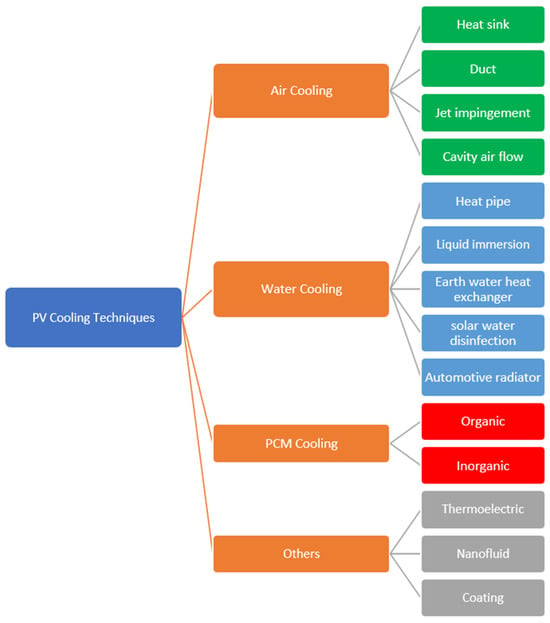
Figure 3.
Classification of cooling techniques.
3.1. Air Cooling Methods
The air cooling method for PV refers to the technique of dissipating heat from PV modules by circulating air around them. It can be implemented in free or forced convection, using heat sinks, fans, or blowers to increase airflow. As shown in Figure 4, natural convection occurs by the means of circulation and heat exchange between hot and cold fluids, this circulation is caused by the buoyancy effect. When the PV panel becomes hot, it warms up the layer of air surrounding it, thus the temperature of air increases, and the density increases accordingly. Consequently, hot air rises, causing a movement called a natural convection current.

Figure 4.
PV panel under free convection with or without a heat sink.
Forced convection is considered one of the most effective heat transfer mechanisms. It is characterized by using external sources such as fans, pumps, and suction devices to aid fluid transportation.
Air cooling is relatively simple and cost-effective, making it a popular choice for cooling PV systems. However, its effectiveness depends on various factors such as ambient temperature, humidity, and wind speed. Heat sinks can be used in conjunction with air cooling to further improve heat dissipation and maintain a stable operating temperature for the PV modules.
Below, we present a summary table that outlines various cooling techniques with both free and forced convection methods for photovoltaic panel cooling.
Table 2 summarizes various cooling methods applied to photovoltaic panels to enhance their efficiency under different convection conditions. The studies cover a spectrum of techniques, including forced convection with ducts and fans, free convection using multi-level fin heat sinks, and hybrid approaches combining free and forced convection with phase-change materials. Results indicate notable improvements in efficiency, ranging from 2.1% to 21.68%, with specific configurations achieving enhanced performance in different climates. Additionally, studies explore novel strategies such as curved eave and vortex generators, graphite-infused PCM, and heat spreaders with cotton wicks. Overall, the studies explore a range of cooling methods and their impacts on PV panel performance, contributing valuable insights to the field of renewable energy.

Table 2.
Free and forced convection cooling methods.
Moreover, the numerical studies in Table 2 have shown more novel approaches in the designs of the cooling methods used in cooling the PV panel. Numerical investigations shown a temperature reduction ranging between 5.89 °C and 27 °C while mainly focusing the studies on using free convection. However, experimental investigations were combining both free and forced convection and comparing their results. Air cooling was found to be effective in significant solar radiation climates, where the temperature of the air is lower than the temperature of the PV’s operating temperature.
3.2. Water Cooling Methods
PV water cooling methods are a set of techniques that involve the use of water or other fluids to absorb and dissipate heat from PV panels, with the goal of improving their electrical performance and prolonging their lifespan. These methods can be implemented through passive or active means and may involve the use of heat sinks, heat exchangers, direct water immersion, or other related approaches. The effectiveness of PV water cooling methods depends on various factors, such as water flow rate, temperature, and quality, as well as the design and construction of the cooling system. Table 3 represents the different cooling techniques that are either passive or active.

Table 3.
Classification of passive and active water-based cooling techniques.
Passive cooling techniques for cooling PV systems refer to natural methods used for reducing the temperature of PV modules without the use of mechanical or electrical devices. They rely on convection, radiation, and evaporation to dissipate heat and improve the performance and lifespan of PV modules.
Tina et al. [50] have increased the electrical efficiency by approximately 10% after experimentally submerging a PV panel inside water in a study of enhancing PV temperature. Figure 5 represents the submerged PV inside a vessel containing water.

Figure 5.
PV panel immersed in water [50].
On the other hand, active water cooling for PV required a mechanical or electrical devices to actively reduce the temperature of PV modules. This may include circulating water or other fluids through a heat exchanger. They are useful in hot climates or high-power output systems and provide greater cooling efficiency and control over operating temperature than passive cooling methods.
Irwan et al. [51], carried an indoor experiment in order to investigate the effect of water flowing at the surface in cooling the PV panel. Results showed that a decrease in PV temperature by 5–23 °C increases the output power of the PV panel by 9–22%.
On the other hand, Moradgholi et al. [52] experimentally investigated the effect of heat pipes in cooling PV panels, and the module used in his experimental study is represented in Figure 6. Results showed an increase of 5.67% in power when using methanol as a working fluid in spring and an increase of 7.7% in power when using acetone as a working fluid in summer.
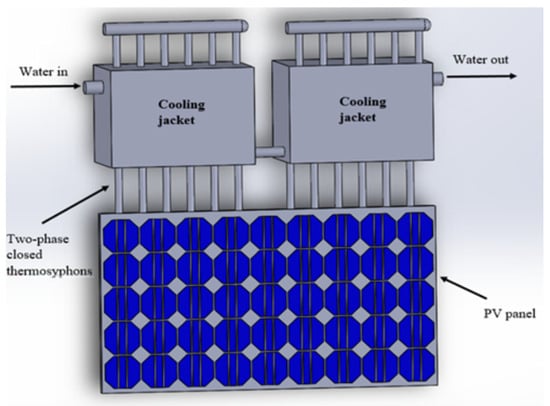
Figure 6.
Heat pipes module [52].
Moreover, Sandeep Koundinya et al. [53] investigated experimentally and by simulation the effect of a finned heat pipe with water as the working fluid in cooling photovoltaic panels. Results showed a total decrease of 13.8 K in PV panel temperature and good agreement was found between experimental and computational studies.
Below, a summary table is presented for several studies about cooling PV modules with passive and active cooling techniques.
Table 4 presents a wide array of outcomes across various cooling methods for photovoltaic panels. Passive approaches, like water-saturated microencapsulated phase-change materials (MEPCM) and immersion in dielectric liquids, effectively reduce temperatures, leading to improved electric efficiency. Passive cooling techniques exhibit diverse results, with efficiency enhancements ranging from 2.7% to 12.4% and a temperature reduction of up to 13.8 K. Active cooling methods, such as spraying water and flowing water on the PV surface, consistently boost power generation and efficiency, demonstrating improvements from 8% to 9% to a significant 24 K temperature decrease. Innovative methods like floating PV on water surfaces and geothermal cooling systems show efficiency increases of 2.7% and up to 13.8%, respectively. The choice between passive and active cooling depends on factors like climate, available resources, and desired efficiency levels. These findings collectively contribute to advancing PV panel cooling, facilitating more efficient and sustainable solar power generation.

Table 4.
Summary of several studies on water-based cooling techniques for PVs.
The use of evaporative cooling could be more beneficial than vapor compression at the level of the cost. However, the system is not reliable or needs more design work [82].
Moreover, it was noticed in the water-cooled methods that the experimental studies mentioned in Table 4 were greater than the numerical studies and the climates the water cooling methods were studied in are hot such as India, Egypt, and Saudi Arabia.
3.3. PCM Cooling Methods
Phase-change materials (PCMs) are substances used in cooling systems for photovoltaic modules to absorb and store heat from the panels during peak sunlight hours. PCMs have a high latent heat of fusion, which means they can absorb large amounts of heat without a significant increase in temperature. PCMs can be integrated into PV panels, or used in a separate thermal management system to enhance the overall efficiency and lifetime of the PV system.
In a typical PV–PCM hybrid system, illustrated in Figure 7, the PCM functions as a heat sink that absorbs excess heat from the PV panel, thereby reducing its temperature. During the peak sun hours, the temperature of the PV panel exceeds the melting temperature of the PCM. As a result, the PCM absorbs excess heat from the PV panel and maintain a stable operating temperature for the PV system until it completely melts, transitioning from solid to liquid phase. During the low sunlight period, as the ambient temperature decreases and the temperature of the PV panel drops below the melting point of the PCM, the PCM releases excess heat and solidifies again.
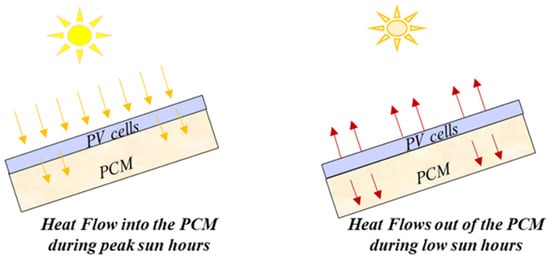
Figure 7.
Typical PV–PCM system [83].
Table 5 summarizes the various cooling techniques using PCM with different combinations and materials.

Table 5.
Summary of PV cooling techniques based on PCMs.
Table 5 presents a comprehensive overview of different phase-change materials utilized in conjunction with photovoltaic (PV) panels. Each entry includes details on the specific PCM used, its melting point, cooling method, test methodology, key outcomes, climate conditions, and the contributing authors. Noteworthy PCMs like white petroleum jelly, paraffin wax, and specialized formulations such as Rubitherm 28 HC and Rubitherm 35 HC are explored across various cooling systems. Passive cooling methods incorporating PCMs exhibit efficiency gains ranging from 1.05% to 12.4%. On the other hand, active systems like PV–PCM configurations and PV/T systems consistently showcase improvements in electric efficiency and power output, reaching up to 24%. These findings underscore the impact of factors such as climate, location, and PCM composition on the effectiveness of these cooling techniques. Overall, Researchers have identified optimal PCM parameters, thicknesses, and integration methods, contributing to the advancement of efficient photovoltaic cooling strategies.
Moreover, cooling by PCM is shown to be used in hot climates where solar irradiation is considered to be high such as in Egypt, Iran, Saudi Arabia, and United Arab Emirates.
3.4. Other Cooling Methods
There are various cooling methods for photovoltaic systems other than air, water, and phase-change materials. One of these methods is using encapsulated PCM, which improves the PCM’s expansion property during melting. Another method is thermoelectric cooling, which uses the Peltier effect to create a temperature difference and transfer heat away from the PV module. Additionally, researchers have explored the use of nanofluids, which are liquids containing nanoparticles that can improve the thermal properties of the cooling fluid. Other methods include using refrigeration systems or hybrid systems that combine multiple cooling methods. Each of these cooling methods has its own advantages and disadvantages and can be suitable for different types of PV systems and operating conditions.
Saleh et al. [111] numerically studied the effect of nanofluid and water in cooling photovoltaic–thermal (PVT) collectors. Results showed that the use of 1% volumetric fraction of nanofluids increases the thermal efficiency up to 19.5% and the electric efficiency up to 55.45%.
Ghadiri et al. [112], experimentally studied the effect of cooling a PVT system by ferrofluids shown in Figure 8. Different fluids were used at a constant and an alternating magnetic field in order to discuss the effect of magnetic field on ferrofluids. Results showed an increase of 45% in the overall efficiency when using ferrofluid and a total increase of 50% in the overall efficiency when using an alternating magnetic field of 50 Hz frequency. Also, a total of 48 W of exergy was increased after using ferrofluid.

Figure 8.
Ferrofluids cooling system [112].
Figure 9 illustrates the use of thermoelectric water-nanofluid cooling and thermoelectric finned heat sink cooling in PV/T and PV systems respectively [113].

Figure 9.
PV with thermoelectric plate and: (a) photovoltaic/thermal-thermoelectric water-nanofluid (PV/T-TEG-NF) cooling system and (b) photovoltaic-thermoelectric finned heat sink (PV/TEG-Hs) cooling system [113].
Table 6 shows the recent studies performed on cooling the PV panel using different methods.

Table 6.
Different cooling techniques.
The outcomes presented in Table 6 highlight the diverse and innovative cooling methods for photovoltaic panels. The utilization of a microencapsulated phase-change material combined with a heat sink, and a thermoelectric generator, demonstrated a 2% efficiency increase in the intermediate season and 2.5% in summer. The integration of PCM with fins and nanofluid (CPV/T/NF/FPCM) showed significant improvements, achieving an electric efficiency of 17.02% and a thermal efficiency of 61.25%. Indoor experiments involving a photovoltaic thermal collector with Nano-PCM and micro-fin tube nanofluid revealed a remarkable thermal efficiency of 77.5% and a 4.01 W increase in electric power. Another noteworthy system, incorporating a micro-fin tube counter clockwise twisted tape nanofluid and nano-PCM, demonstrated a substantial 44.5% increase in electric power. The PV/nano-enhanced PCM heat sink system displayed enhancements, including a 91.81% increase in thermal conductivity, a 6.6 °C temperature reduction, and a 3% improvement in electricity output. Further experiments, incorporating PCM, thermoelectric cooling, and aluminum fins, yielded the highest power generation enhancement of 47.88 Watts. Additionally, a numerical simulation of a PV/T system with a spectrum-splitting module revealed an impressive conversion efficiency exceeding 43%. These advancements hold promise for improving the energy efficiency and sustainability of photovoltaic panels and increasing the adoption of renewable energy sources.
4. Discussion and Analysis
The literature has provided numerous methods for cooling the PV panel and increasing its efficiency, resulting in methods with more effectiveness over others. With different methods of cooling, different ranges of efficiency arise that were obtained and illustrated in Figure 10.
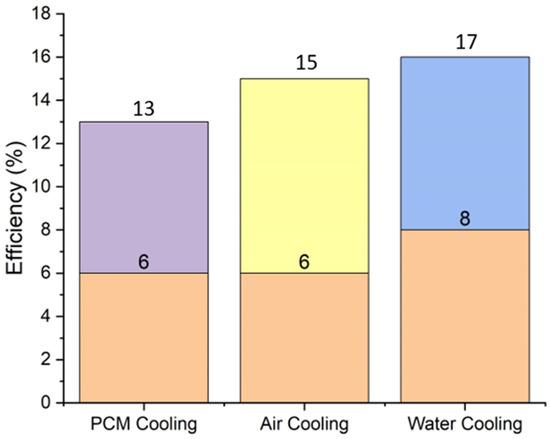
Figure 10.
Efficiencies of cooling methods.
According to the literature, efficiency ranged between 6% and 13% when PCM was used as a cooling technique. This method had both advantages and disadvantages. Through all the previous studies, the main problem that faced the researchers is the low thermal conductivity of PCM, and the change in volume when PCM melts, which in turn leads to poor temperature management. Researchers tried to solve these problems through several ways such as mixing PCM with graphite and developing a shape-stabilized PCM. In contrast, the advantages of this method were the simplicity of the cooling system, the low cost, and the long lifetime. With the need for only a tank filled with PCM attached to the back of the PV panel, the price of this system was low, and with the absence of electrical instruments, there will be no need for maintenance.
The air cooling techniques literature revealed a range of efficiency between 6% and 15%, and several methods were tested experimentally and numerically based on natural convection and forced convection. Several systems were tested by scientists such as finned plates, fans and air ducts, finned plates combined with fans and air ducts, and jet impingements. Others tried to combine the effects of the latent heat storage of PCM along with finned plates under natural and forced convection. The simplest method and most effective was using finned plates under forced or natural convection. Under forced convection, a better efficiency was recorded but a higher cost compared with the use of finned plates under natural convection. Therefore, there is no method better than another in general; but in specific conditions, optimization between efficiency and cost can be achieved. In a windy location, a finned free convective system will give great efficiency with low cost, while in a non-windy location, a finned forced convective system would cost a little bit more but will give a higher efficiency.
The highest efficiency was recorded when water cooling systems were tested. Different techniques were taken into consideration, spraying water over the surface of the panel, immersion of the panel in water, using water as a circulation fluid in heat pipes attached to the back of the PV, etc. Efficiency with water systems ranged in the literature between 8% and 17%, but designing systems to deal with water had a high cost because of the need for pumps, pipes, fittings, etc. In addition, when taking the location of the project into consideration, a water cooling system was the best technique in dusty or sandy places, where high efficiency could be maintained by removing dust from the front surface of the panel which would otherwise reduce the amount of irradiation received.
5. Economic Study
After cooling the PV panels, cooling techniques showed an increase in power for each PV panel with different increased values. This increase in power showed a remarkable increase financially when compared to the standard PV. Economic and environmental analyses were conducted on a PV panel with an area of 0.218 .
The governing equations used in the economic study are presented as follows.
where
E: The energy produced by the PV panel in .
I: The average solar insolation per day in .
: The effective area of the PV panel in .
: The electrical efficiency of the PV panel.
The relative efficiency is the relative difference between the cooled PV efficiency and the standard PV. This relative efficiency is used to calculate the absolute electrical efficiency of each cooled PV case and is quantified as:
where
: The efficiency of cooled PV (%).
: The efficiency of standard PV (%).
Savings were quantified as:
where
E: The energy produced by the PV panel in .
S: The price of each .
5.1. Water Cooling
The sun hours vary according to the months of the year. Figure 11 shows the variation in the sun hours with respect to the months in Lebanon. As shown in the following figure, July month reached the maximum of 438.2 h.
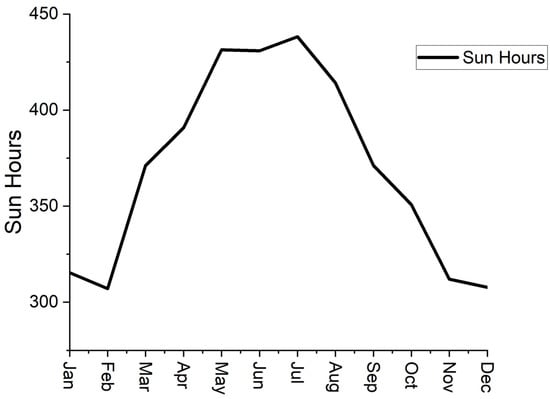
Figure 11.
Number of sun hours versus months.
The solar insolation in Beirut, Lebanon is shown in Figure 12 [121].
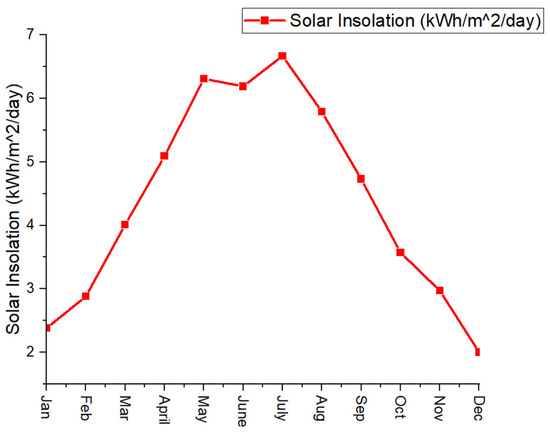
Figure 12.
Solar insolation in Beirut, Lebanon [121].
As shown in Figure 12, the minimum solar insolation was recorded in December, with a value of 2 per day. The highest solar insolation was recorded in July, with a value of 6.67 per day.
Water cooling methods were found to be effective in cooling the PV panels. As shown in Figure 13, flowing water on the surface of the PV panel was found to produce the maximum energy, with an average of 32.29 kWh compared to the other cooling methods. Following this method, the liquid immersion method, with an average of 32.17 kWh, proved to be the next best. Also, the heat pipe cooling system recorded an average of 31 kWh, while the automotive radiator system recorded the least energy between the cooling methods, with an average of 30.55 kWh. The standard PV panel recorded an average of 29.24 kWh.
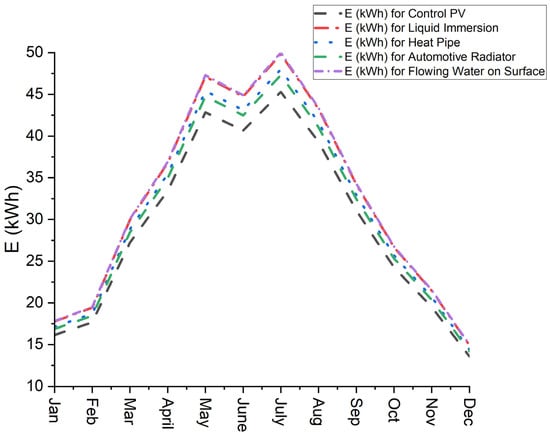
Figure 13.
Energy produced versus months for water cooling methods.
Figure 14 shows that the maximum cost saving by the cooling methods was recorded for flowing water on the surface cooling method, with an average cost saving of United States Dollar (USD) 0.273. The liquid immersion method follows, with an average cost saving of USD 0.263, and the heat pipe cooling method showed an average cost saving of USD 0.157. The automotive radiator cooling method showed the lowest average cost saving, as shown in the following figure with an average compared to a standard PV panel of USD 0.117.
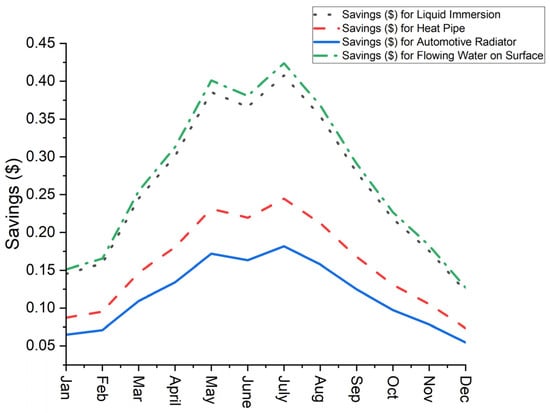
Figure 14.
Cost savings versus months for water cooling methods.
5.2. Air Cooling
In air cooling methods, the exhaust air cooling method was found to produce the maximum energy output, with an average of 32.201 kWh. Figure 15 shows the variation in energy produced for air cooling methods with respect to the months of the year.
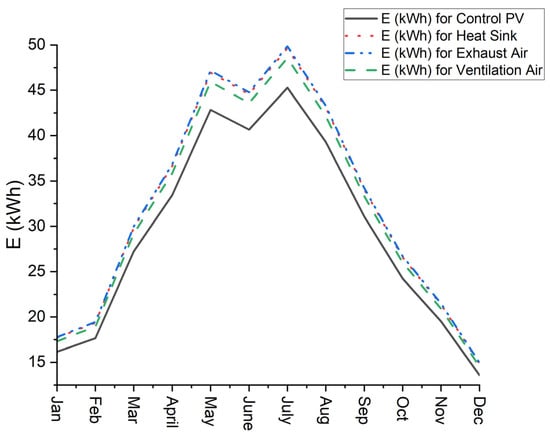
Figure 15.
Energy produced versus months for air cooling methods.
As shown in Figure 16, the exhaust air cooling method showed the highest cost savings, with an average of USD 0.265.
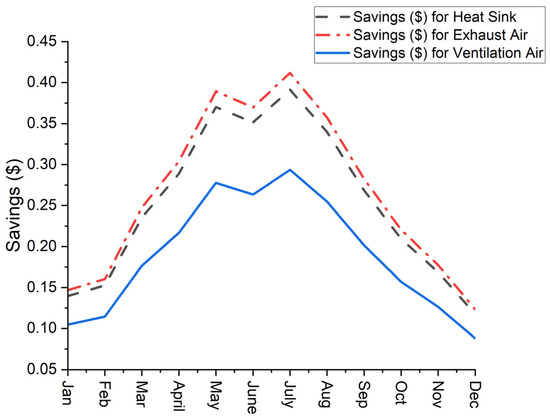
Figure 16.
Cost savings versus months for air cooling methods.
5.3. PCM Cooling
Figure 17 shows that cooling by PCM increased the total energy produced compared to the standard PV panel. An average of 31.733 kWh was recorded for cooling by PCM compared to an average of 37 kWh recorded for the standard PV panel.
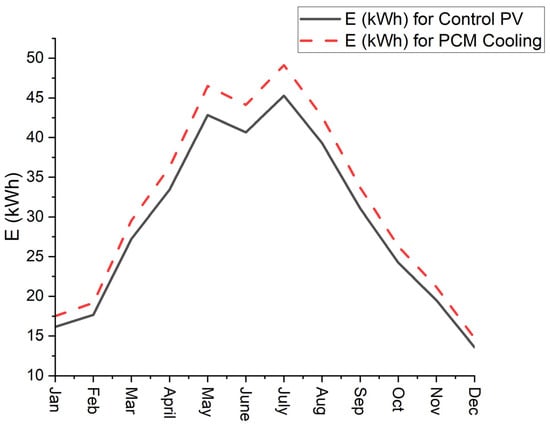
Figure 17.
Energy produced versus months for PCM cooling method.
Cooling by PCM increased cost savings compared to the standard PV panel. Figure 18 shows that the maximum amount of money saved by PCM cooling was USD 0.223.
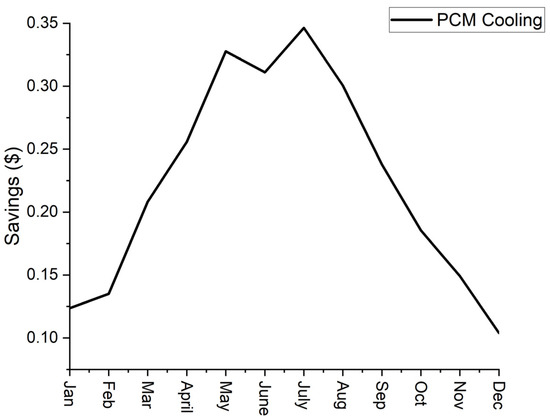
Figure 18.
Cost savings versus months for PCM cooling method.
5.4. Other Cooling Methods
As shown in Figure 19, the thermoelectric cooling method was found to produce the maximum energy, with an average of 34.512 kWh.
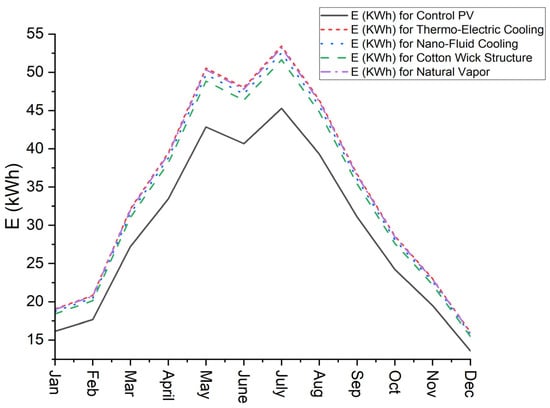
Figure 19.
Energy produced versus months for other cooling methods.
The maximum cost saving was recorded by the thermoelectric cooling method, with an average of USD 0.473 recorded in July, as shown in Figure 20.
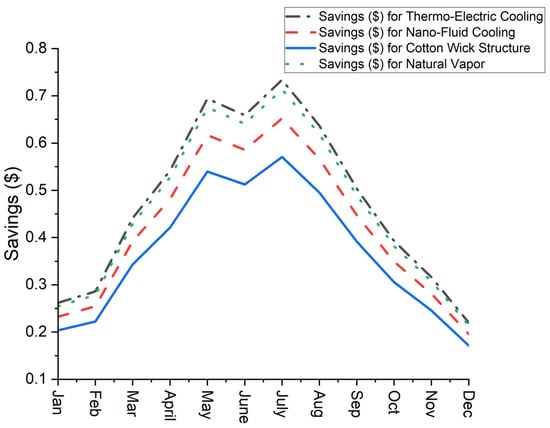
Figure 20.
Cost savings versus months for other cooling methods.
In the realm of photovoltaic panel cooling methods, the economic evaluation highlighted the significant benefits of these technologies, both in terms of increased energy production and cost savings compared to standard PV systems. Water-based cooling methods, exemplified by flowing water on the PV panel, have exhibited the highest energy production, yielding an average of 32.29 kWh. This translated into significant financial gains, with cost savings averaging USD 0.273. Liquid immersion and heat pipe cooling systems also demonstrated promising results, while automotive radiator-based cooling methods exhibited slightly lower energy gains and cost savings. In the air cooling category, exhaust air cooling proved to be the most effective, generating an average of 32.201 kWh and yielding the highest cost savings of USD 0.265. Additionally, phase-change material cooling strategies contributed to increased energy production, with an average of 31.73 kWh, resulting in notable cost savings of up to USD 0.223. Among various cooling methods, thermoelectric cooling emerged as the leader in energy production, delivering an average of 34.512 kWh and recording the highest cost savings—particularly in July, with an average of USD 0.473. These results confirm the economic feasibility and financial advantages of applying advanced cooling technologies in PV panel systems, enhancing their ability to drive sustainable and cost-effective energy solutions.
6. Environmental Study
The increased use of fossil fuels has increased CO2 emissions, which pollutes the air and leads to many serious problems, mainly global warming. Photovoltaic panels were found to reduce CO2 emissions to the atmosphere as a renewable energy resource.
The governing equations used in the environmental study are as follows.
The CO2 reduction value is quantified as:
where
: The amount of CO2 reduced in .
: Energy produced by a PV panel in .
: The amount of CO2 produced per 1 kWh of electricity
6.1. Water Cooling
Water cooling methods had a major impact on cooling techniques in reducing CO2 emissions as a renewable energy resource. A system of nozzles flowing water on the surface of the PV panel was found to result in the maximum CO2 reduction of 26.509 kg with respect to the other water cooling methods, as shown in Figure 21.
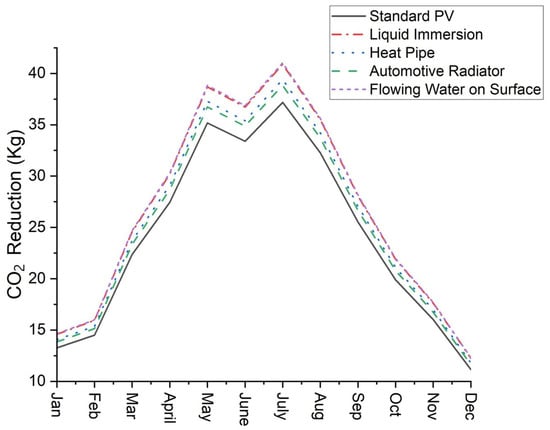
Figure 21.
CO2 emission reduction versus month for water cooling methods.
6.2. Air Cooling
The air cooling technique CO2 emission reduction varies between the methods. However, as shown in Figure 22, the exhaust air system had the maximum CO2 emission reduction, with an average of 26.437 kg, compared the other methods.
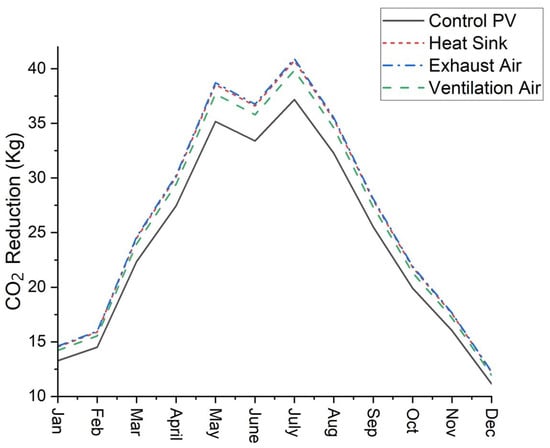
Figure 22.
CO2 emission reduction versus months for air cooling methods.
6.3. PCM Cooling
The PCM cooling method was found to reduce CO2 emissions by an average of 26.053 kg, as shown in Figure 23.
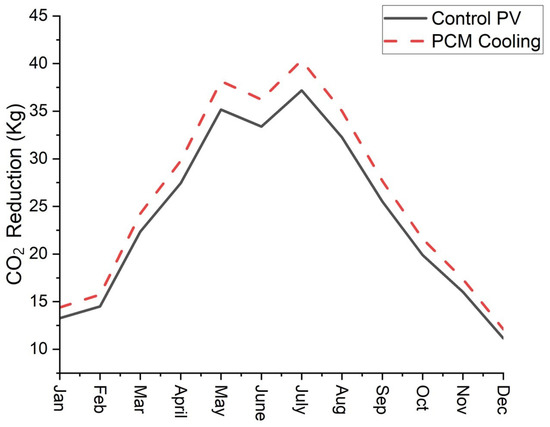
Figure 23.
CO2 emission reduction versus months for PCM cooling method.
6.4. Other Cooling Methods
Other uncategorized cooling techniques had a good impact on the reduction in CO2 emissions. The thermoelectric cooling system had a maximum reduction in CO2 emissions, with an average of 28.334 kg, as shown in Figure 24.
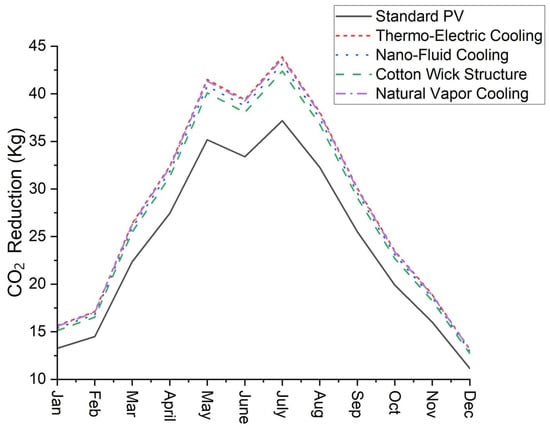
Figure 24.
CO2 emission reduction versus months for other cooling methods.
In short, the escalating use of fossil fuels has led to an alarming rise in carbon dioxide emissions, which has greatly contributed to worsening environmental issues such as global warming. Photovoltaic panels have emerged as a renewable energy resource with the potential to mitigate these emissions. This study investigated different cooling technologies and their effectiveness in reducing carbon dioxide emissions. Of these, water cooling methods, particularly the nozzle-based system, showed the greatest impact, reducing emissions by 26.509 kg. Air cooling technologies, especially the exhaust air system, also played a decisive role, achieving an average reduction of 26.437 kg. PCM cooling methods contributed to an average weight reduction of 26.053 kg. Even other unclassified cooling technologies, such as the thermoelectric cooling system, succeeded in reducing CO2 emissions, with an average reduction of 28.334 kg. These results underscore the pivotal role of photovoltaic panels not only in generating renewable energy but also in combating carbon dioxide emissions. As the world grapples with the necessity of tackling climate change, innovative cooling strategies offer promising ways to reduce carbon dioxide emissions, thus promoting a more sustainable and environmentally conscious future.
7. Payback Period
The payback period of each system was studied as investments in order to reveal how much each system approximately costs and how much time it would need to pay the initial investment.
The payback period is quantified by the following equation.
where
Income: Profit produced by the system.
Cost: Initial cost of the system.
Figure 25 shows the payback period for the systems consisting of one PV panel each. As shown in the following figure, the automotive radiator system needs approximately 7.576 years in order to pay the initial investment while the standard PV needs approximately 1.9 years.

Figure 25.
Payback period of each system.
As shown in Figure 25, the return on invest period differs drastically based on the initial investment paid for each system. The standard PV needs approximately 1.9 years to return the initial investment, while the automotive radiator and nanofluid cooling systems need approximately 7.576 years to return the initial investment paid from their enhanced electric output.
It is true that the payback period has increased when constructing a cooling technique for the PV panel; however, the benefits of the cooling technique on the PV are far more beneficial. The PV panel lifespan increases whenever a cooling system is used because a cooling system decreases its temperature with time. The increase in green energy produced by the PV panel with a cooling system could benefit the environment and be a smart investment on bigger systems, where in the case of cooling, the system needs fewer PV panels to operate and produce higher power outputs, while contributing with a decrease in CO2 emissions.
8. Conclusions and Recommendations
This review paper addresses the importance of effective cooling strategies to enhance the efficiency of photovoltaic panels. It highlights the negative impact of high temperatures on the performance of photovoltaic panels and emphasizes the necessity of efficient cooling technologies. This review thoroughly explores and discusses a variety of cooling methods, including traditional methods such as water and air cooling, along with innovative solutions such as incorporating phase-change materials, thermoelectric cooling, heat pipes, evaporative cooling, and nanofluids. Furthermore, this review takes into account environmental and economic factors to comprehensively assess the impact of cooling on the performance of photovoltaic panels.
Additionally, the findings of this review emphasize that all evaluated cooling methods have the potential to improve the electrical efficiency of PV panels. However, specific techniques stand out for their superior performance. Notably, among these approaches, the automatic water spraying system, exhaust ventilated air, phase-change materials, and thermoelectric cooling methods exhibited the highest energy production levels. In terms of cost-effectiveness, thermoelectric cooling outperformed evaporative cooling, water-nanofluid cooling, and the automatic spraying system. Furthermore, thermoelectric cooling, evaporative cooling, exhaust-ventilated air, and automatic water spraying demonstrated the greatest reductions in CO2 emissions.
Moreover, the evaporative cooling technique, along with thermoelectric and PCM cooling methods, showed the shortest payback period. Consequently, evaporative and thermoelectric cooling emerge as particularly promising choices, offering substantial energy improvements, positive environmental effects, and favorable returns on investment. These results emphasize the importance of integrating cooling strategies to improve the efficiency of photovoltaic panels and to maximize the generation of eco-friendly electricity. Given the essential role of renewable energy in addressing climate change and the transition to sustainable energy systems, the integration of efficient cooling technologies can contribute significantly to the advancement of the renewable energy sector.
The development of a highly conductive phase-change material would increase the effect of PCM cooling, enhancing the efficiency and performance of the PV panel. Studies should be targeted on testing different combinations of PCM with other materials, and on the PCM itself to reach a formula where the thermal conductivity is as high as possible and the melting point of the PCM is as close as possible to the standard test conditions of the PV panel. Also, as a future recommendation, the period of analysis at the level of the cooling techniques and methods could be for longer periods, meaning that each cooling method should be studied over different periods of time and for longer hours. Moreover, not many review studies combine all of the cooling methods in one paper. This study mentions nearly all of the cooling methods and a parametric investigation was conducted at the level of environmental and economic analysis, a state-of-the art analysis.
Funding
This research received no external funding.
Conflicts of Interest
The authors declare no conflict of interest.
References
- Khaled, M.; Harambat, F.; Hage, H.E.; Peerhossaini, H. Spatial Optimization of an Underhood Cooling Module—Towards an Innovative Control Approach. Appl. Energy 2011, 88, 3841–3849. [Google Scholar] [CrossRef]
- Khaled, M.; Harambat, F.; Peerhossaini, H. Towards the Control of Car Underhood Thermal Conditions. Appl. Therm. Eng. 2011, 31, 902–910. [Google Scholar] [CrossRef]
- Khaled, M.; Harambat, F.; Peerhossaini, H. Temperature and Heat Flux Behavior of Complex Flows in Car Underhood Compartment. Heat Transf. Eng. 2010, 31, 1057–1067. [Google Scholar] [CrossRef]
- Taher, R.; Ahmed, M.M.; Haddad, Z.; Abid, C. Poiseuille-Rayleigh-Bénard Mixed Convection Flow in a Channel: Heat Transfer and Fluid Flow Patterns. Int. J. Heat Mass Transf. 2021, 180, 121745. [Google Scholar] [CrossRef]
- Razi, F.; Dincer, I. Renewable Energy Development and Hydrogen Economy in MENA Region: A Review. Renew. Sustain. Energy Rev. 2022, 168, 112763. [Google Scholar] [CrossRef]
- Haddad, A.; Ramadan, M.; Khaled, M.; Ramadan, H.S.M.; Becherif, M. Triple Hybrid System Coupling Fuel Cell with Wind Turbine and Thermal Solar System. Int. J. Hydrogen Energy 2020, 45, 11484–11491. [Google Scholar] [CrossRef]
- Khaled, M.; Ramadan, M.; Hage, H.E. Parametric Analysis of Heat Recovery from Exhaust Gases of Generators. Energy Procedia 2015, 75, 3295–3300. [Google Scholar] [CrossRef]
- Du, W.; Yin, Q.; Cheng, L. Experiments on Novel Heat Recovery Systems on Rotary Kilns. Appl. Therm. Eng. 2018, 139, 535–541. [Google Scholar] [CrossRef]
- Hage, H.E.; Ramadan, M.; Jaber, H.; Khaled, M.; Olabi, A.G. A Short Review on the Techniques of Waste Heat Recovery from Domestic Applications. Energy Sources Part A Recovery Util. Environ. Eff. 2019, 42, 3019–3034. [Google Scholar] [CrossRef]
- Akbari, A.; Kouravand, S.; Chegini, G. Experimental Analysis of a Rotary Heat Exchanger for Waste Heat Recovery from the Exhaust Gas of Dryer. Appl. Therm. Eng. 2018, 138, 668–674. [Google Scholar] [CrossRef]
- Gomaa, M.R.; Ahmed, M.; Rezk, H. Temperature Distribution Modeling of PV and Cooling Water PV/T Collectors through Thin and Thick Cooling Cross-Fined Channel Box. Energy Rep. 2022, 8, 1144–1153. [Google Scholar] [CrossRef]
- Jiao, C.; Li, Z. An updated review of solar cooling systems driven by Photovoltaic–Thermal collectors. Energies 2023, 16, 5331. [Google Scholar] [CrossRef]
- Ibrahim, K.A.; Luk, P.; Luo, Z. Cooling of Concentrated Photovoltaic Cells—A review and the perspective of Pulsating flow Cooling. Energies 2023, 16, 2842. [Google Scholar] [CrossRef]
- Herrando, M.; Wang, K.; Huang, G.; Otanicar, T.; Mousa, O.B.; Agathokleous, R.A.; Ding, Y.; Kalogirou, S.A.; Ekins-Daukes, N.J.; Taylor, R.A.; et al. A review of solar hybrid photovoltaic-thermal (PV-T) collectors and systems. Prog. Energy Combust. Sci. 2023, 97, 101072. [Google Scholar] [CrossRef]
- Ghosh, A. A Comprehensive Review of Water Based PV: Flotavoltaics, under Water, Offshore & Canal Top. Ocean Eng. 2023, 281, 115044. [Google Scholar] [CrossRef]
- Aslam, A.; Ahmed, N.; Qureshi, S.A.; Assadi, M.; Ahmed, N. Advances in Solar PV Systems; A Comprehensive Review of PV Performance, Influencing Factors, and Mitigation Techniques. Energies 2022, 15, 7595. [Google Scholar] [CrossRef]
- Herrando, M.; Ramos, A.C. Photovoltaic-Thermal (PV-T) systems for combined cooling, heating and power in buildings: A review. Energies 2022, 15, 3021. [Google Scholar] [CrossRef]
- Hajjaj, S.S.H.; Aqeel, A.A.K.A.; Sultan, M.T.H.; Shahar, F.S.; Shah, A.U.M. Review of recent efforts in cooling photovoltaic panels (PVs) for enhanced performance and better impact on the environment. Nanomaterials 2022, 12, 1664. [Google Scholar] [CrossRef]
- Hammoumi, A.E.; Chtita, S.; Motahhir, S.; Ghzizal, A.E. Solar PV energy: From material to use, and the most commonly used techniques to maximize the power output of PV systems: A focus on solar trackers and floating solar panels. Energy Rep. 2022, 8, 11992–12010. [Google Scholar] [CrossRef]
- Sheik, M.S.; Kakati, P.; Dandotiya, D.; Udaya Ravi, M.; Ramesh, C.S. A Comprehensive Review on Various Cooling Techniques to Decrease an Operating Temperature of Solar Photovoltaic Panels. Energy Nexus 2022, 8, 100161. [Google Scholar] [CrossRef]
- Cui, Y.; Zhu, J.; Zhang, F.; Shao, Y.; Xue, Y. Current status and future development of hybrid PV/T system with PCM module: 4E (energy, exergy, economic and environmental) assessments. Renew. Sustain. Energy Rev. 2022, 158, 112147. [Google Scholar] [CrossRef]
- Mahdavi, A.; Farhadi, M.; Gorji-Bandpy, M.; Mahmoudi, A.H. A review of passive cooling of photovoltaic devices. Clean. Eng. Technol. 2022, 11, 100579. [Google Scholar] [CrossRef]
- Kandeal, A.; Algazzar, A.M.; Elkadeem, M.R.; Thakur, A.K.; Abdelaziz, G.B.; El-Said, E.M.; Elsaid, A.M.; An, M.; Kandel, R.; Fawzy, H.E.; et al. Nano-enhanced cooling techniques for photovoltaic panels: A systematic review and prospect recommendations. Sol. Energy 2021, 227, 259–272. [Google Scholar] [CrossRef]
- Awasthi, A.; Shukla, A.K.; Manohar, S.R.M.; Dondariya, C.; Shukla, K.K.; Porwal, D.; Richhariya, G. Review on sun tracking technology in solar PV system. Energy Rep. 2020, 6, 392–405. [Google Scholar] [CrossRef]
- Jathar, L.D.; Ganesan, S.; Awasarmol, U.; Nikam, K.C.; Shahapurkar, K.; Soudagar, M.E.M.; Fayaz, H.; El-Shafay, A.; Kalam, M.A.; Boudila, S.; et al. Comprehensive review of environmental factors influencing the performance of photovoltaic panels: Concern over emissions at various phases throughout the lifecycle. Environ. Pollut. 2023, 326, 121474. [Google Scholar] [CrossRef]
- Şahin, G. Effect of Wavelength on the Electrical Parameters of a Vertical Parallel Junction Silicon Solar Cell Illuminated by Its Rear Side in Frequency Domain. Results Phys. 2016, 6, 107–111. [Google Scholar] [CrossRef]
- Maka, A.O.; O’Donovan, T.S. Effect of thermal load on performance parameters of solar concentrating photovoltaic: High-efficiency solar cells. Energy Built Environ. 2022, 3, 201–209. [Google Scholar] [CrossRef]
- Paudyal, B.R.; Imenes, A.G. Investigation of temperature coefficients of PV modules through field measured data. Sol. Energy 2021, 224, 425–439. [Google Scholar] [CrossRef]
- Chander, S.; Purohit, A.; Sharma, A.; Arvind, A.; Nehra, S.; Dhaka, M.S. A study on photovoltaic parameters of mono-crystalline silicon solar cell with cell temperature. Energy Rep. 2015, 1, 104–109. [Google Scholar] [CrossRef]
- Hussien, A.A.; Eltayesh, A.; El-Batsh, H.M. Experimental and numerical investigation for PV cooling by forced convection. Alex. Eng. J. 2022, 64, 427–440. [Google Scholar] [CrossRef]
- Ahmad, E.Z.; Fazlizan, A.; Jarimi, H.; Sopian, K.; Ibrahim, A. Enhanced heat dissipation of truncated multi-level fin heat sink (MLFHS) in case of natural convection for photovoltaic cooling. Case Stud. Therm. Eng. 2021, 28, 101578. [Google Scholar] [CrossRef]
- Abdallah, A.; Opoku, R.; Sekyere, C.; Boahen, S.; Amoabeng, K.O.; Uba, F.; Obeng, G.Y.; Forson, F. Experimental investigation of thermal management techniques for improving the efficiencies and levelized cost of energy of solar PV modules. Case Stud. Therm. Eng. 2022, 35, 102133. [Google Scholar] [CrossRef]
- Pomares-Hernández, C.; Zuluaga-García, E.A.; Escorcia Salas, G.E.; Robles-Algarín, C.; Sierra Ortega, J. Computational Modeling of Passive and Active Cooling Methods to Improve PV Panels Efficiency. Appl. Sci. 2021, 11, 11370. [Google Scholar] [CrossRef]
- Wang, Y.; Zhao, T.; Cao, Z.; Zhai, C.; Zhou, Y.; Lv, W.; Xu, T.; Wu, S. Numerical study on the forced convection enhancement of flat-roof integrated photovoltaic by passive components. Energy Build. 2023, 289, 113063. [Google Scholar] [CrossRef]
- Kasaeian, A.; Khanjari, Y.; Golzari, S.; Mahian, O.; Wongwises, S. Effects of forced convection on the performance of a photovoltaic thermal system: An experimental study. Exp. Therm. Fluid Sci. 2017, 85, 13–21. [Google Scholar] [CrossRef]
- Atkin, P.; Farid, M. Improving the efficiency of photovoltaic cells using PCM infused graphite and aluminium fins. Sol. Energy 2015, 114, 217–228. [Google Scholar] [CrossRef]
- Chandrasekar, M.; Senthilkumar, T. Experimental demonstration of enhanced solar energy utilization in flat PV (photovoltaic) modules cooled by heat spreaders in conjunction with cotton wick structures. Energy 2015, 90, 1401–1410. [Google Scholar] [CrossRef]
- Benzarti, S.; Chaabane, M.; Mhiri, H.; Bournot, P. Performance improvement of a naturally ventilated building integrated photovoltaic system using twisted baffle inserts. J. Build. Eng. 2022, 53, 104553. [Google Scholar] [CrossRef]
- Grubišić-Čabo, F.; Nižetić, S.; Čoko, D.; Kragić, I.; Papadopoulos, A.M. Experimental investigation of the passive cooled free-standing photovoltaic panel with fixed aluminum fins on the backside surface. J. Clean. Prod. 2018, 176, 119–129. [Google Scholar] [CrossRef]
- Mojumder, J.C.; Chong, W.T.; Show, P.L.; Leong, K.W.; Abdullah-Al-Mamoon. An experimental investigation on performance analysis of air type photovoltaic thermal collector system integrated with cooling fins design. Energy Build. 2016, 130, 272–285. [Google Scholar] [CrossRef]
- Abdelsalam, E.; Alnawafah, H.; Almomani, F.; Mousa, A.; Jamjoum, M.; Alkasrawi, M. Efficiency Improvement of Photovoltaic Panels: A Novel Integration Approach with Cooling Tower. Energies 2023, 16, 1070. [Google Scholar] [CrossRef]
- Soliman, A.M. A Numerical Investigation of PVT System Performance with Various Cooling Configurations. Energies 2023, 16, 3052. [Google Scholar] [CrossRef]
- Al-Amri, F.; Saeed, F.; Mujeebu, M.A. Novel dual-function racking structure for passive cooling of solar PV panels–thermal performance analysis. Renew. Energy 2022, 198, 100–113. [Google Scholar] [CrossRef]
- Bayrak, F.; Oztop, H.F.; Selimefendigil, F. Effects of different fin parameters on temperature and efficiency for cooling of photovoltaic panels under natural convection. Sol. Energy 2019, 188, 484–494. [Google Scholar] [CrossRef]
- Hu, W.; Li, X.; Wang, J.; Tian, Z.; Zhou, B.; Wu, J.; Li, R.; Li, W.; Ma, N.; Kang, J.; et al. Experimental research on the convective heat transfer coefficient of photovoltaic panel. Renew. Energy 2021, 185, 820–826. [Google Scholar] [CrossRef]
- Kumar, P.S.; NaveenKumar, R.; Sharifpur, M.; Issakhov, A.; Ravichandran, M.; Maridurai, T.; Al-Sulaiman, F.A.; Banapurmath, N.R. Experimental investigations to improve the electrical efficiency of photovoltaic modules using different convection mode. Sustain. Energy Technol. Assess. 2021, 48, 101582. [Google Scholar] [CrossRef]
- Mankani, K.L.; Chaudhry, H.N.; Calautit, J.K. Optimization of an air-cooled heat sink for cooling of a solar photovoltaic panel: A computational study. Energy Build. 2022, 270, 112274. [Google Scholar] [CrossRef]
- Kiwan, S.; Khlefat, A.M. Thermal cooling of photovoltaic panels using porous material. Case Stud. Therm. Eng. 2021, 24, 100837. [Google Scholar] [CrossRef]
- Li, D.; King, M.; Dooner, M.S.; Guo, S.; Wang, J. Study on the cleaning and cooling of solar photovoltaic panels using compressed airflow. Sol. Energy 2021, 221, 433–444. [Google Scholar] [CrossRef]
- Tina, G.M.; Rosa-Clot, M.; Rosa-Clot, P.; Scandura, P.F. Optical and thermal behavior of submerged photovoltaic solar panel: SP2. Energy 2012, 39, 17–26. [Google Scholar] [CrossRef]
- Irwan, Y.; Leow, W.; Irwanto, M.; Fareq, M.; Amelia, A.; Gomesh, N.; Safwati, I. Indoor Test Performance of PV Panel through Water Cooling Method. Energy Procedia 2015, 79, 604–611. [Google Scholar] [CrossRef]
- Moradgholi, M.; Nowee, S.M.; Abrishamchi, I. Application of heat pipe in an experimental investigation on a novel photovoltaic/thermal (PV/T) system. Sol. Energy 2014, 107, 82–88. [Google Scholar] [CrossRef]
- Koundinya, S.; Vigneshkumar, N.; Krishnan, A.S. Experimental Study and Comparison with the Computational Study on Cooling of PV Solar Panel Using Finned Heat Pipe Technology. Mater. Today Proc. 2017, 4, 2693–2700. [Google Scholar] [CrossRef]
- Ho, C.; Chou, W.Y.; Lai, C.M. Thermal and electrical performance of a water-surface floating PV integrated with a water-saturated MEPCM layer. Energy Convers. Manag. 2015, 89, 862–872. [Google Scholar] [CrossRef]
- Liu, L.; Zhu, L.; Wang, Y.; Huang, Q.; Sun, Y.; Yin, Z. Heat dissipation performance of silicon solar cells by direct dielectric liquid immersion under intensified illuminations. Sol. Energy 2011, 85, 922–930. [Google Scholar] [CrossRef]
- Nižetić, S.; Čoko, D.; Yadav, A.; Grubišić-Čabo, F. Water spray cooling technique applied on a photovoltaic panel: The performance response. Energy Convers. Manag. 2016, 108, 287–296. [Google Scholar] [CrossRef]
- Joy, B.; Philip, J.; Zachariah, R. Investigations on serpentine tube type solar photovoltaic/thermal collector with different heat transfer fluids: Experiment and numerical analysis. Sol. Energy 2016, 140, 12–20. [Google Scholar] [CrossRef]
- Moharram, K.A.; Kandil, H.A.; El-Sherif, H. Enhancing the performance of photovoltaic panels by water cooling. Ain Shams Eng. J. 2013, 4, 869–877. [Google Scholar] [CrossRef]
- Yazdanifard, F.; Ebrahimnia-Bajestan, E.; Ameri, M. Investigating the performance of a water-based photovoltaic/thermal (PV/T) collector in laminar and turbulent flow regime. Renew. Energy 2016, 99, 295–306. [Google Scholar] [CrossRef]
- Krauter, S. Increased electrical yield via water flow over the front of photovoltaic panels. Sol. Energy Mater. Sol. Cells 2004, 82, 131–137. [Google Scholar] [CrossRef]
- Sabry, M. Temperature optimization of high concentrated active cooled solar cells. NRIAG J. Astron. Geophys. 2016, 5, 23–29. [Google Scholar] [CrossRef]
- Elnozahy, A.; Rahman, A.K.A.; Ali, A.H.H.; Abdel-Salam, M.; Ookawara, S. Performance of a PV module integrated with standalone building in hot arid areas as enhanced by surface cooling and cleaning. Energy Build. 2015, 88, 100–109. [Google Scholar] [CrossRef]
- Kordzadeh, A. The effects of nominal power of array and system head on the operation of photovoltaic water pumping set with array surface covered by a film of water. Renew. Energy 2010, 35, 1098–1102. [Google Scholar] [CrossRef]
- Arcuri, N.; Reda, F.; De Simone, M. Energy and thermo-fluid-dynamics evaluations of photovoltaic panels cooled by water and air. Sol. Energy 2014, 105, 147–156. [Google Scholar] [CrossRef]
- Jakhar, S.; Soni, M.; Gakkhar, N. Performance Analysis of Earth Water Heat Exchanger for Concentrating Photovoltaic Cooling. Energy Procedia 2016, 90, 145–153. [Google Scholar] [CrossRef]
- Mittelman, G.; Kribus, A.; Mouchtar, O.; Dayan, A. Water desalination with concentrating photovoltaic/thermal (CPVT) systems. Sol. Energy 2009, 83, 1322–1334. [Google Scholar] [CrossRef]
- Chong, K.; Tan, W. Study of automotive radiator cooling system for dense-array concentration photovoltaic system. Sol. Energy 2012, 86, 2632–2643. [Google Scholar] [CrossRef]
- Ibrahim, A.M.; Dincer, I. Experimental performance evaluation of a combined solar system to produce cooling and potable water. Sol. Energy 2015, 122, 1066–1079. [Google Scholar] [CrossRef]
- Korkut, T.B.; Gören, A.; Rachid, A. Numerical and Experimental Study of a PVT Water System under Daily Weather Conditions. Energies 2022, 15, 6538. [Google Scholar] [CrossRef]
- Sattar, M.; Rehman, A.; Ahmad, N.; Mohammad, A.; Alahmadi, A.; Ullah, N. Performance Analysis and Optimization of a Cooling System for Hybrid Solar Panels Based on Climatic Conditions of Islamabad, Pakistan. Energies 2022, 15, 6278. [Google Scholar] [CrossRef]
- Sornek, K.; Goryl, W.; Figaj, R.D.; Dąbrowska, G.B.; Brezdeń, J. Development and Tests of the Water Cooling System Dedicated to Photovoltaic Panels. Energies 2022, 15, 5884. [Google Scholar] [CrossRef]
- Majumder, A.; Innamorati, R.; Ghiani, E.; Kumar, A.; Gatto, G. Performance Analysis of a Floating Photovoltaic System and Estimation of the Evaporation Losses Reduction. Energies 2021, 14, 8336. [Google Scholar] [CrossRef]
- Yildirim, M.; Cebula, A.; Sułowicz, M. A cooling design for photovoltaic panels—Water-based PV/T system. Energy 2022, 256, 124654. [Google Scholar] [CrossRef]
- Chanphavong, L.; Chanthaboune, V.; Phommachanh, S.; Vilaida, X.; Bounyanite, P. Enhancement of performance and exergy analysis of a water-cooling solar photovoltaic panel. Total Environ. Res. Themes 2022, 3–4, 100018. [Google Scholar] [CrossRef]
- Panda, S.; Panda, B.; Jena, C.; Nanda, L.; Pradhan, A. Investigating the similarities and differences between front and back surface cooling for PV panels. Mater. Today Proc. 2022, 74, 358–363. [Google Scholar] [CrossRef]
- Zubeer, S.A.; Ali, O. Experimental and numerical study of low concentration and water-cooling effect on PV module performance. Case Stud. Therm. Eng. 2022, 34, 102007. [Google Scholar] [CrossRef]
- Lopez-Pascual, D.; Valiente-Blanco, I.; Manzano-Narro, O.; Fernandez-Munoz, M.; Diez-Jimenez, E. Experimental characterization of a geothermal cooling system for enhancement of the efficiency of solar photovoltaic panels. Energy Rep. 2022, 8, 756–763. [Google Scholar] [CrossRef]
- Li, S.; Zhou, Z.; Liu, J.; Zhang, J.; Tang, H.; Zhuofen, Z.; Na, Y.; Jiang, C. Research on indirect cooling for photovoltaic panels based on radiative cooling. Renew. Energy 2022, 198, 947–959. [Google Scholar] [CrossRef]
- Masalha, I.; Masuri, S.; Badran, O.; Ariffin, M.; Talib, A.A.; Alfaqs, F. Outdoor experimental and numerical simulation of photovoltaic cooling using porous media. Case Stud. Therm. Eng. 2023, 42, 102748. [Google Scholar] [CrossRef]
- Jafari, R. Optimization and energy analysis of a novel geothermal heat exchanger for photovoltaic panel cooling. Sol. Energy 2021, 226, 122–133. [Google Scholar] [CrossRef]
- Sudhakar, P.; Santosh, R.; Asthalakshmi, B.; Kumaresan, G.; Velraj, R. Performance augmentation of solar photovoltaic panel through PCM integrated natural water circulation cooling technique. Renew. Energy 2021, 172, 1433–1448. [Google Scholar] [CrossRef]
- Pezzutto, S.; Quaglini, G.; Rivière, P.; Kranzl, L.; Novelli, A.; Zambito, A.; Wilczynski, E. Screening of cooling technologies in Europe: Alternatives to vapour compression and possible market developments. Sustainability 2022, 14, 2971. [Google Scholar] [CrossRef]
- Waqas, A.; Ji, J.; Xu, L.; Ali, M.; Zeashan; Alvi, J.Z. Thermal and Electrical Management of Photovoltaic Panels Using Phase Change Materials—A Review. Renew. Sustain. Energy Rev. 2018, 92, 254–271. [Google Scholar] [CrossRef]
- Hachem, F.; Abdulhay, B.; Ramadan, M.; Hage, H.E.; Rab, M.G.E.; Khaled, M. Improving the performance of photovoltaic cells using pure and combined phase change materials—Experiments and transient energy balance. Renew. Energy 2017, 107, 567–575. [Google Scholar] [CrossRef]
- Smith, C.; Forster, P.M.; Crook, R. Global analysis of photovoltaic energy output enhanced by phase change material cooling. Appl. Energy 2014, 126, 21–28. [Google Scholar] [CrossRef]
- Biwole, P.H.; Eclache, P.; Kuznik, F. Phase-change materials to improve solar panel’s performance. Energy Build. 2013, 62, 59–67. [Google Scholar] [CrossRef]
- Hasan, A.; McCormack, S.; Huang, M.; Sarwar, J.; Norton, B. Increased photovoltaic performance through temperature regulation by phase change materials: Materials comparison in different climates. Sol. Energy 2015, 115, 264–276. [Google Scholar] [CrossRef]
- Xu, Z.; Kong, Q.; Qu, H.; Wang, C. Cooling characteristics of solar photovoltaic panels based on phase change materials. Case Stud. Therm. Eng. 2023, 41, 102667. [Google Scholar] [CrossRef]
- Aneli, S.; Arena, R.; Gagliano, A. Numerical Simulations of a PV Module with Phase Change Material (PV-PCM) under Variable Weather Conditions. Int. J. Heat Technol. 2021, 39, 643–652. [Google Scholar] [CrossRef]
- Amalu, E.H.; Fabunmi, O.A. Thermal control of crystalline silicon photovoltaic (c-Si PV) module using Docosane phase change material (PCM) for improved performance. Sol. Energy 2022, 234, 203–221. [Google Scholar] [CrossRef]
- Zhao, J.; Li, Z.; Ma, T. Performance analysis of a photovoltaic panel integrated with phase change material. Energy Procedia 2019, 158, 1093–1098. [Google Scholar] [CrossRef]
- Kant, K.; Shukla, A.; Sharma, A.; Biwole, P.H. Heat transfer studies of photovoltaic panel coupled with phase change material. Sol. Energy 2016, 140, 151–161. [Google Scholar] [CrossRef]
- Park, J.; Kim, T.; Leigh, S.B. Application of a phase-change material to improve the electrical performance of vertical-building-added photovoltaics considering the annual weather conditions. Sol. Energy 2014, 105, 561–574. [Google Scholar] [CrossRef]
- Stropnik, R.; Stritih, U. Increasing the efficiency of PV panel with the use of PCM. Renew. Energy 2016, 97, 671–679. [Google Scholar] [CrossRef]
- Aelenei, L.; Pereira, R.N.C.; Gonçalves, H.; Athienitis, A.K. Thermal Performance of a Hybrid BIPV-PCM: Modeling, Design and Experimental Investigation. Energy Procedia 2014, 48, 474–483. [Google Scholar] [CrossRef]
- Li, Z.; Ma, T.; Zhao, J.; Song, A.; Cheng, Y. Experimental study and performance analysis on solar photovoltaic panel integrated with phase change material. Energy 2019, 178, 471–486. [Google Scholar] [CrossRef]
- Hasan, A.; Sarwar, J.; Alnoman, H.; Abdelbaqi, S. Yearly energy performance of a photovoltaic-phase change material (PV-PCM) system in hot climate. Sol. Energy 2017, 146, 417–429. [Google Scholar] [CrossRef]
- Savvakis, N.; Dialyna, E.; Tsoutsos, T. Investigation of the operational performance and efficiency of an alternative PV + PCM concept. Sol. Energy 2020, 211, 1283–1300. [Google Scholar] [CrossRef]
- Abdelrazik, A.; Al-Sulaiman, F.A.; Saidur, R. Numerical investigation of the effects of the nano-enhanced phase change materials on the thermal and electrical performance of hybrid PV/thermal systems. Energy Convers. Manag. 2020, 205, 112449. [Google Scholar] [CrossRef]
- Fayaz, H.; Rahim, N.A.; Hasanuzzaman, M.; Rivai, A.K.; Nasrin, R. Numerical and outdoor real time experimental investigation of performance of PCM based PVT system. Sol. Energy 2019, 179, 135–150. [Google Scholar] [CrossRef]
- Hossain, M.S.; Pandey, A.K.; Selvaraj, J.; Rahim, N.A.; Islam, M.S.; Tyagi, V. Two side serpentine flow based photovoltaic-thermal-phase change materials (PVT-PCM) system: Energy, exergy and economic analysis. Renew. Energy 2019, 136, 1320–1336. [Google Scholar] [CrossRef]
- Kazemian, A.; Taheri, A.; Sardarabadi, A.; Ma, T.; Passandideh-Fard, M.; Peng, J. Energy, exergy and environmental analysis of glazed and unglazed PVT system integrated with phase change material: An experimental approach. Sol. Energy 2020, 201, 178–189. [Google Scholar] [CrossRef]
- Metwally, H.; Mahmoud, N.A.; Aboelsoud, W.; Ezzat, M. Comprehensive analysis of PCM container construction effects PV panels thermal management. Adv. Environ. Waste Manag. Recycl. 2022, 5, 326–338. [Google Scholar]
- Bria, A.; Raillani, B.; Chaatouf, D.; Salhi, M.; Amraqui, S.; Mezrhab, A. Numerical investigation of the PCM effect on the performance of photovoltaic panels; comparison between different types of PCM. In Proceedings of the 2022 2nd International Conference on Innovative Research in Applied Science, Engineering and Technology (IRASET), Meknes, Morocco, 3–4 March 2022. [Google Scholar] [CrossRef]
- Hassabou, A.; Isaifan, R.J. Simulation of Phase Change Material Absorbers for Passive Cooling of Solar Systems. Energies 2022, 15, 9288. [Google Scholar] [CrossRef]
- Cui, Y.; Zhu, J.; Zoras, S.; Hassan, K.; Tong, H. Photovoltaic/Thermal Module Integrated with Nano-Enhanced Phase Change Material: A Numerical Analysis. Energies 2022, 15, 4988. [Google Scholar] [CrossRef]
- Soliman, A.S.; Xu, L.; Dong, J.; Cheng, P. A novel heat sink for cooling photovoltaic systems using convex/concave dimples and multiple PCMs. Appl. Therm. Eng. 2022, 215, 119001. [Google Scholar] [CrossRef]
- Maghrabie, H.M.; Mohamed, A.; Fahmy, A.M.; Samee, A.a.A. Performance enhancement of PV panels using phase change material (PCM): An experimental implementation. Case Stud. Therm. Eng. 2023, 42, 102741. [Google Scholar] [CrossRef]
- Chaichan, M.T.; Kazem, H.A.; Al-Waeli, A.H.; Sopian, K. Controlling the melting and solidification points temperature of PCMs on the performance and economic return of the water-cooled photovoltaic thermal system. Sol. Energy 2021, 224, 1344–1357. [Google Scholar] [CrossRef]
- Nižetić, S.; Jurčević, M.; Čoko, D.; Arıcı, M. A novel and effective passive cooling strategy for photovoltaic panel. Renew. Sustain. Energy Rev. 2021, 145, 111164. [Google Scholar] [CrossRef]
- Saleh, A.H.; Hussein, A.M.; Danook, S.H. Efficiency Enhancement of Solar Cell Collector Using Fe3O4/Water Nanofluid. IOP Conf. Ser. 2021, 1105, 012059. [Google Scholar] [CrossRef]
- Ghadiri, M.; Sardarabadi, M.; Pasandideh-Fard, M.; Moghadam, A.J. Experimental Investigation of a PVT System Performance Using Nano Ferrofluids. Energy Convers. Manag. 2015, 103, 468–476. [Google Scholar] [CrossRef]
- Lekbir, A.; Hassani, S.; Ghani, M.R.A.; Gan, C.K.; Mekhilef, S.; Saidur, R. Improved Energy Conversion Performance of a Novel Design of Concentrated Photovoltaic System Combined with Thermoelectric Generator with Advance Cooling System. Energy Convers. Manag. 2018, 177, 19–29. [Google Scholar] [CrossRef]
- Kang, Y.; Joung, J.; Kim, M.; Jeong, J. Energy impact of heat pipe-assisted microencapsulated phase change material heat sink for photovoltaic and thermoelectric generator hybrid panel. Renew. Energy 2023, 207, 298–308. [Google Scholar] [CrossRef]
- Kouravand, A.; Kasaeian, A.; Pourfayaz, F.; Rad, M.A.V. Evaluation of a nanofluid-based concentrating photovoltaic thermal system integrated with finned PCM heatsink: An experimental study. Renew. Energy 2022, 201, 1010–1025. [Google Scholar] [CrossRef]
- Bassam, A.M.; Sopian, K.; Ibrahim, A.; Fauzan, M.F.; Al-Aasam, A.B.; Abusaibaa, G.Y. Experimental analysis for the photovoltaic thermal collector (PVT) with nano PCM and micro-fins tube nanofluid. Case Stud. Therm. Eng. 2022, 41, 102579. [Google Scholar] [CrossRef]
- Bassam, A.M.; Sopian, K.; Ibrahim, A.; Al-Aasam, A.B.; Dayer, M. Experimental analysis of photovoltaic thermal collector (PVT) with nano PCM and micro-fins tube counterclockwise twisted tape nanofluid. Case Stud. Therm. Eng. 2023, 45, 102883. [Google Scholar] [CrossRef]
- Moein-Jahromi, M.; Rahmanian-Koushkaki, H.; Rahmanian, S.; Jahromi, S.P. Evaluation of nanostructured GNP and CuO compositions in PCM-based heat sinks for photovoltaic systems. J. Energy Storage 2022, 53, 105240. [Google Scholar] [CrossRef]
- Bayrak, F.; Oztop, H.F.; Selimefendigil, F. Experimental study for the application of different cooling techniques in photovoltaic (PV) panels. Energy Convers. Manag. 2020, 212, 112789. [Google Scholar] [CrossRef]
- Xu, Q.; Ji, Y.; Riggs, B.C.; Ollanik, A.; Farrar-Foley, N.; Ermer, J.; Romanin, V.; Lynn, P.; Codd, D.S.; Escarra, M.D. A transmissive, spectrum-splitting concentrating photovoltaic module for hybrid photovoltaic-solar thermal energy conversion. Sol. Energy 2016, 137, 585–593. [Google Scholar] [CrossRef]
- Bayssary, A.; Hajjar, C. Solar Irradiation Data for Lebanon. The Lebanese Center for Energy Conservation (LCEC). 2020. Available online: https://lcec.org.lb/sites/default/files/2021-02/Solar%20Irradiation%20Data%20for%20Lebanon%20August%202020.pdf (accessed on 8 November 2023).
Disclaimer/Publisher’s Note: The statements, opinions and data contained in all publications are solely those of the individual author(s) and contributor(s) and not of MDPI and/or the editor(s). MDPI and/or the editor(s) disclaim responsibility for any injury to people or property resulting from any ideas, methods, instructions or products referred to in the content. |
© 2024 by the authors. Licensee MDPI, Basel, Switzerland. This article is an open access article distributed under the terms and conditions of the Creative Commons Attribution (CC BY) license (https://creativecommons.org/licenses/by/4.0/).